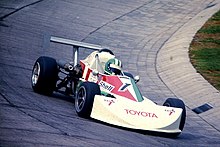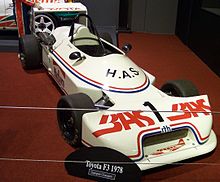Formula 3


The formula 3 is a Motorsport -Rennklasse, which the factory-heavy formulas ( brand formulas ) how the formula King , Formula Renault , Formula Ford , Formula BMW , and other as well as the Formula 4 is located. Across Europe, it is considered the preliminary stage for the higher classes (formerly Formula 3000 , today Formula 2 and Formula 1 ). In Formula 3, as in Formula 4, you can collect points for the super license .
history
After the Second World War, monoposto racing cars with 500 cm³ motorcycle engines were mainly built in England . The most famous brand was Cooper , first with J.-A.-P. Engines and later with Norton - Manx engines. The engine and motorcycle gearbox were installed behind the driver in front of the rear axle. The power was transferred by a chain to the gearbox and from there a second chain to the rear axle, the differential gear was considered a special accessory. The wheels were individually suspended , with lower wishbones and a transverse leaf spring on top. Later wagons were extremely light, around 240 kg dry, they had a tubular lattice frame and magnesium wheels. The main competitors were Kieft and Martin. Both manufacturers no longer work in this area today. German Formula 3 cars in the post-war years were Scampolo and Monopoletta with engines from DKW , BMW and Fiat .
In 1957, the Italian racing driver and journalist Giovanni Lurani brought Formula Junior to life with the aim of making it possible to enter motorsport at a low cost . The series was very popular around the world, and from 1959 many national championships were held around the globe. A German Formula Junior Championship was held from 1960 to 1963, with Gerhard Mitter and Kurt Ahrens dominating the championship .
In 1964 the displacement of Formula Junior was limited to 1000 cm³ and the class was renamed Formula 3 by the FIA. The car had to weigh at least 400 kg, the engine had to come from a production car, a maximum of 4 cylinders and one carburetor were allowed. Successful chassis manufacturers in the early days of Formula 3 under the FIA were: Chevron, Lola, Cooper, Brabham, Lotus and Tecno.
In 1971 the Formula 3 regulations were revised, the engine displacement was increased to 1600 cm³ and the air flow limiter that is common today was introduced. The vehicles became more aerodynamic, got front and rear wings and tires without profile ( slicks ). New smaller manufacturers such as March and GRD introduced the first aluminum monocoques (shell construction instead of lattice frames ), established manufacturers such as Lotus, Brabham and Cooper left Formula 3 to design vehicles for Formula 1 and Formula 2. The most successful engine of the time was the Lotus Twin Cam, a Ford Kent with a Lotus aluminum cylinder head with two overhead camshafts . Tuners such as Holbay, Novamoto or Vegatune modified the engines to achieve outputs of around 120 hp (88 kW).
In 1974 new regulations were introduced. The engine displacement was increased to 2000 cm³, the diameter of the air inlet to 24 mm, and the minimum weight of the vehicles to 440 kg. Aluminum monocoques were now used by all manufacturers. Formula 3 became increasingly popular and in 1975 the Formula 3 Nations European Cup was expanded by the FIA to become the European Formula 3 championship . In the same year, the German Formula 3 Cup was launched in Germany. From 1979, the ground effect also moved into Formula 3 and the appearance of the vehicles changed significantly. Instead of aluminum monocoques, monocoques made of carbon fiber reinforced plastic were gradually used.
After an unsuccessful Formula 1 project, Dallara developed a Formula 3 chassis in 1993 with which he was able to almost completely oust the competing vehicle manufacturers Reynard and Ralt from most of the Formula 3 championships within a short period of time.
After the FIA decided to introduce Formula 4 regulations in 2013 and the previous GP2 series was renamed the FIA Formula 2 Championship in 2017, the FIA World Council published new regulations for Formula 3 in September 2017. While Formula 4 is national and Formula 2 is international, Formula 3 is to be continental. In addition to the European Formula 3 Championship, an American Formula 3 Championship and an Asian Formula 3 Championship are to be added from 2018.
Formula 3 Cup
The Formula 3 is in Germany has been held since 1975 as German Cup and Formula 3 Cup and respectfully called "the school of the Grand Prix Stars". Many current Formula 1 and DTM drivers were active in Formula 3 and also more or less successful. Formula 3 is in many countries the highest national single-seater race series. Automobiles with four wheels and near-series engines from the manufacturers Opel , VW , Fiat, Toyota , BMW, Alfa Romeo and Mercedes-Benz , which were manufactured for speed races on circuits or closed circuits, are used. The light alloy wheel manufacturer ATS has been the official main sponsor since the 2007 season and the Formula 3 Cup operates under the name “ATS Formula 3 Cup”.
Euro series
Since 2003 there has been the Euro Series with races in several European countries. The nationally oriented events, where the technical effort does not have to be pushed so high, are somewhat in the shadows.
Almost every country with a noteworthy activity in motorsport also holds Formula 3 races. Due to the internationally uniform regulations, one would think that an Italian F3 would be very similar to an English or German one. But this is not the case because different tires are required in each country. The technology of an F3 is so exhausted that a different suspension setup is necessary due to a different tire. This continues up to the gear ratio and engine control. The outwardly identical cars except for the tires therefore differ considerably in their driving behavior.
Technical regulations
chassis
The current homologation period for the chassis is valid until December 31, 2019.
The chassis have been homologated by the following companies by the end of 2019:
Basic technical data:
- Total width: 185 cm
- Width in front of the front wheels: 130 cm
- Width between front and rear wheels: 130 cm
- Width of the rear wing: 90 cm
- Height without roll bar: 90 cm
- Minimum wheelbase: 200 cm
- Minimum track width: 120 cm
- Minimum weight: 550 kg including driver
engine
According to the FIA regulations, homologation for Formula 3 engines is required. The current homologation period for the engines is valid until December 31, 2019. The engines should be so stable that they run 10,000 km without revision. The maximum price of an engine is 65,500 euros. The engines may have a maximum displacement of 2000 cm³ and a maximum of 4 cylinders. An air flow limiter with a diameter of 26 mm is also required.
The following engines have been homologated by the end of 2019:
-
 M-TEC : MF204D
M-TEC : MF204D -
 Mercedes-Benz : F3-414
Mercedes-Benz : F3-414 -
 Neil Brown Engineering : NBE4
Neil Brown Engineering : NBE4 -
 Renault Sport : RST / OMC
Renault Sport : RST / OMC -
 Toda Racing : TR-F301
Toda Racing : TR-F301 -
 Tomei Powered Inc : TB14F3
Tomei Powered Inc : TB14F3 -
 TOM’S : TAZ31
TOM’S : TAZ31 -
 Volkswagen : 0XY
Volkswagen : 0XY
Further Formula 3 championships
International championships
- European Formula 3 Championship (1975–1984, 2012–2018)
- European Formula 3 Cup (1985–1990, 1999–2004)
- FIA Formula 3 Trophy (2011)
- FIA Formula 3 Championship (from 2019)
- Formula European Masters (from 2019)
National championships
- French Formula 3 Championship (1964-2002)
- British Formula 3 Championship (1951-)
- Italian Formula 3 Championship (1964-2012)
- Japanese Formula 3 Championship (1979-)
- European F3 Open ( Spanish Formula 3 Championship until 2008 ) (2001-)
- South American Formula 3 Championship (1987-2013)
- Mexican Formula 3 Championship (1990-2002)
- Chilean Formula 3 Championship (1972-)
- Australian Formula 3 Championship (1964-1977; 1999-)
- Nordic F3 Masters (1958-1960; 1984-1986; 2000-2010)
- Austria Formula 3 Cup (1982-)
Web links
- Official website
- Formula 3 Euro Series
- History and results
- Complete regulations (PDF file; 210 kB)
Individual evidence
- ^ History of Formula 3: A Series with tradition. fiaf3europe.com, accessed on January 11, 2018 .
- ↑ 20 years of Formula 3 history. hra-online.de, accessed on January 11, 2018 .
- ^ FIA Announces World Motor Sport Council Decisions. fia.com, accessed on January 11, 2018 .
- ↑ IA Formula 3 European Championship offers enhanced package for 2017
- ↑ Peter Allen: New F3 series to support F1 from 2019. Formula Scout, March 9, 2018, accessed on December 16, 2018 (English).
- ↑ Peter Allen: European F3 becomes Formula European Masters for 2019. Formula Scout, December 4, 2018, accessed on December 16, 2018 (English).





